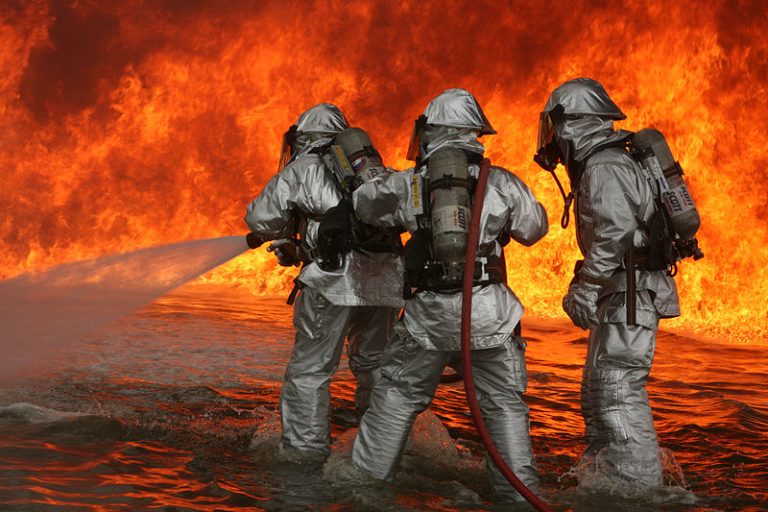With technology making all of our lives easier (in theory at least), you’d think that fighting fires would be getting easier too. Yet this doesn’t seem to be the case. We see the pressures of global warming with wildfires in America and Portugal; tragedies such as Grenfell and the recent Kemerovo shopping centre fire; and the continued pressures on public services to save money and increase efficiency. This is not to mention unseen issues such as rising levels of obesity, which are forcing emergency personnel to adapt their training methods and invest in new equipment; or the rise of cheap construction and cramped conditions, due to growing populations and demand. In other words, something needs to change in the way fires are prevented, fought and managed. Here then are just a few examples of the technologies that could keep us safer in future. Wearable tech Firefighters would be the first to embrace tech that helps them do their jobs better. Unfortunately, they often can’t carry it. The average weight of standard issue equipment is between 10-12kg, meaning that any extra baggage could compromise their ability to navigate buildings and save lives. As a result, much of the focus of firefighting tech is now on compacting tools and utilising lightweight devices. Take for instance the thermal imaging camera, which allows firefighters to locate people and navigate fires through thick smoke. Instead of carrying a cumbersome bit of carried equipment, this information could be transmitted through the firefighter’s existing visor, either using augmented reality (AR) technology or a toggle for normal and thermal imaging camera views. Getting rid of the need for a camera would eliminate a distraction for the firefighter, and leave their hands free for more important tasks. The quick, seamless and hands-free transmission of data is a pivotal element in the future of firefighting. Some cities are already working on central databases of building information, which can be transmitted to firefighters to help them navigate the inside of a building, and assess its unique risks. Strangely enough, driverless cars may also help with this. The need for consistent 4G internet may improve signal quality within buildings for both data transfer and audio communication, which is often impeded in tower block and skyscraper fires. Strength and conditioning It isn’t just the fires that are likely to get tougher or more numerous; people may get harder to save, too. The obesity epidemic has already forced fire departments to train their crews differently, and to carry different kinds of lifting and hoisting equipment. It’s arguable that with this and the potential increases in the weight of equipment, firefighters will need to be fitter than ever, and capable of lifting greater weights. One technology that may assist with this is the exosuit. These wearable exoskeletons are designed to provide mechanical assistance for basic functions, such as walking or lifting objects. Think about the suit Ripley fights the xenomorph in at the end of Aliens, and you’ll be on the right track. The intended purpose isn’t that far off, either: not for fighting deadly predators, perhaps, but the intended purpose of heavy lifting with more dexterity than a forklift truck. Current exosuits are primarily being designed for warehouse workers to prevent injuries while lifting, as well as for elderly and disabled people to increase their mobility. But the benefits for emergency personnel are obvious. By assisting with movement and carrying extra weight, an exosuit could allow firefighters to shoulder more equipment, move more quickly and carry people more easily. The only barrier is to ensure that they are completely fireproof and infallible in emergency situations, so they never become more of a hindrance than a help. AI and simulation Smarter technology may not be the sole preserve of the firefighters; it may also come from the buildings. The sensors in ‘smart buildings’ are already revolutionising workplace productivity, saving energy and maintaining comfortable environmental conditions. Applying the same tech to fire prevention and management could radically decrease the impact of fires, as well as better preparing first responders to tackle a blaze. Building sensors can already detect fires in specific rooms, but communicating this is often a manual process on the part of fire wardens. Advanced sensors could show not only where the fire started but where it is and how hot it is burning. Moreover, early communication of this information could allow firefighters to predict the path of fires. AI modelling could pull from a database of building details (such as layouts and composition) to predict how the fire will spread in real time, and advise responders on where they should focus their efforts. Outside of an active fire situation, AI can also help us better analyse the conditions in which fires take place. We are still discovering how fires react in certain situations with different combinations of materials, as evidenced by the way the Grenfell fire subverted official guidelines to remain in the flats. Computer analysis could help to simulate fires that would otherwise be difficult or costly, and help inform building design and fire codes. Fire suppression We may be able to improve our understanding of fires, but we’ll still have to fight them sometimes. As a result, new technologies to improve the suppression of fires are highly sought after, and the focus of numerous competing startups. As it turns out, there may be better means to fight fires than the traditional use of water, foam and gases. One explosive (and rather counterintuitive) example is the use of ‘freeze grenades’. A container of controlled chemicals or powders can be set to break open at high temperatures, cutting out a fire at its heart – although this isn’t suitable everywhere. Perhaps more familiar are the attempts to redesign the humble fire hose. One proposed design is a ‘lance’ hose, which can supposedly fire through the brickwork of a building, spreading a fine mist across a larger surface area. Future firefighting tech isn’t just limited to these traditional substances, though. Two engineering students








